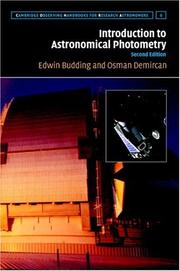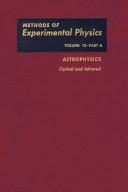| Listing 1 - 5 of 5 |
Sort by
|

ISBN: 9780511536175 9780521847117 9780511335037 0511335032 0511536178 0521847117 9780511333798 051133379X 1107152623 128104010X 9786611040109 1139131125 0511334451 0511333110 Year: 2007 Publisher: Cambridge : Cambridge University Press,
Abstract | Keywords | Export | Availability | Bookmark
 Loading...
Loading...Choose an application
- Reference Manager
- EndNote
- RefWorks (Direct export to RefWorks)
Completely updated, this second edition gives a broad review of astronomical photometry to provide an understanding of astrophysics from a data-based perspective. It explains the underlying principles of the instruments used, and the applications and inferences derived from measurements. Each chapter has been fully revised to account for the latest developments, including the use of CCDs. Highly illustrated, this book provides an overview and historical background of the subject before reviewing the main themes within astronomical photometry. The central chapters focus on the practical design of the instruments and methodology used. The book concludes by discussing specialised topics in stellar astronomy, concentrating on the information derived from the analysis of the light curves of variable stars and close binary systems. It includes numerous bibliographic notes and a glossary of terms. It is ideal for graduate students, academic researchers and advanced amateurs interested in practical and observational astronomy.
Astronomical photometry. --- Astrometry. --- Positional astronomy --- Spherical astronomy --- Brightness (Astronomy) --- Photometry, Astronomical --- Photometry

ISBN: 9780124759121 0124759122 9786611768362 1281768367 0080859909 Year: 1974 Volume: 12 Publisher: New York London Academic Press
Abstract | Keywords | Export | Availability | Bookmark
 Loading...
Loading...Choose an application
- Reference Manager
- EndNote
- RefWorks (Direct export to RefWorks)
Astrophysis Optical and Infrared
Science. --- Astronomy. --- 520.8 --- Techniques of observation, measurement, analysis --- 520.8 Techniques of observation, measurement, analysis --- Astronomical spectroscopy. --- Astronomical photometry. --- Brightness (Astronomy) --- Photometry, Astronomical --- Photometry --- Spectroscopy, Astronomical --- Absorption spectra --- Astrophysics --- Spectrum analysis

ISBN: 9780387293653 0387293655 9786610944842 1280944846 0387333916 Year: 2006 Publisher: New York, NY : Springer New York : Imprint: Springer,
Abstract | Keywords | Export | Availability | Bookmark
 Loading...
Loading...Choose an application
- Reference Manager
- EndNote
- RefWorks (Direct export to RefWorks)
A Practical Guide to Lightcurve Photometry and Analysis provides, for those with access to even a modest telescope and CCD camera, all the information needed to take part in the scientific study of asteroids and variable stars. Using commercially available equipment, amateur astronomers can determine the rotation rate, size, and shape of asteroids. Similarly, it is possible to discover the size, temperature, and orbits of stars in binary systems by using this powerful technique. A Practical Guide to Lightcurve Photometry and Analysis contains all the material needed for readers to understand the theory, and avoid the practical pitfalls of lightcurve photometry. Detailed examples are given for obtaining data, and of course for the exciting and rewarding task of analyzing the data to determine the physical properties of the object. Any college student or amateur astronomer who wants to go beyond mere imaging with a CCD camera and enter the challenging world of "real science" via the lightcurves of asteroids and binary stars will find everything necessary in this book.
Astronomical photometry. --- Photométrie astronomique --- Astronomy. --- Nature -- Sky observation. --- Astronomical photometry --- Astronomy - General --- Astronomy & Astrophysics --- Physical Sciences & Mathematics --- Photométrie astronomique --- EPUB-LIV-FT LIVPHYSI SPRINGER-B --- Brightness (Astronomy) --- Photometry, Astronomical --- Physics. --- Astrophysics. --- Cosmology. --- Observations, Astronomical. --- Astronomy --- Astronomy, Observations and Techniques. --- Astrophysics and Astroparticles. --- Astronomy, Astrophysics and Cosmology. --- Observations. --- Photometry --- Astronomy—Observations. --- Astronomical physics --- Cosmic physics --- Physics --- Astronomical observations --- Observations, Astronomical
Book
ISBN: 3319327496 331932750X Year: 2016 Publisher: Cham : Springer International Publishing : Imprint: Springer,
Abstract | Keywords | Export | Availability | Bookmark
 Loading...
Loading...Choose an application
- Reference Manager
- EndNote
- RefWorks (Direct export to RefWorks)
For those with access to even a modest telescope and CCD camera, this new and improved guide delivers all the information needed to take part in the scientific study of asteroids and variable stars. New techniques in photometry continue to be refined, and expert Brian Warner covers the developing territory in detail for those both new and experienced. Updated to reflect changes in telescope and CCD technology, it also includes an expanded chapter on the analysis of asteroid lightcurves to cover some of the common pitfalls that lead to incorrect answers as well as how to discover an asteroid satellite via lightcurves. With this information, amateur astronomers can use commercially available equipment to determine the rotation rate, size, and shape of asteroids. Similarly, it is possible to discover the size, temperature, and orbits of stars in binary systems by using this powerful technique. Brian Warner yet again delivers all the material needed for readers to understand the theory, and avoid the practical pitfalls of lightcurve photometry. Detailed examples are given for obtaining data, and of course for the exciting and rewarding task of analyzing the data to determine the physical properties of the objects. It also includes many detailed finder charts with magnitudes for reference and detailed steps on how to go about gathering data for specific projects without misinterpretation. Any college student or amateur astronomer who wants to go beyond mere imaging with a CCD camera and enter the challenging world of "real science" via the lightcurves of asteroids and binary stars will find everything necessary in this updated book. .
Popular works. --- Photography. --- Observations, Astronomical. --- Astronomy --- Optics. --- Optoelectronics. --- Plasmons (Physics). --- Astronomy. --- Popular Science. --- Popular Science in Astronomy. --- Astronomy, Observations and Techniques. --- Optics, Optoelectronics, Plasmonics and Optical Devices. --- Observations. --- Astronomical photometry. --- Brightness (Astronomy) --- Photometry, Astronomical --- Photometry --- Optics, Lasers, Photonics, Optical Devices. --- Astronomy—Observations. --- Lasers. --- Photonics. --- New optics --- Optics --- Light amplification by stimulated emission of radiation --- Masers, Optical --- Optical masers --- Light amplifiers --- Light sources --- Optoelectronic devices --- Nonlinear optics --- Optical parametric oscillators --- Astronomical observations --- Observations, Astronomical
Book
ISBN: 1441980490 1441980504 Year: 2011 Publisher: New York, NY : Springer New York : Imprint: Springer,
Abstract | Keywords | Export | Availability | Bookmark
 Loading...
Loading...Choose an application
- Reference Manager
- EndNote
- RefWorks (Direct export to RefWorks)
This book brings together experts in the field of astronomical photometry to discuss how their subfields provide the precision and accuracy in astronomical energy flux measurements that are needed to permit tests of astrophysical theories. Differential photometers and photometry, improvements in infrared precision, the improvements in precision and accuracy of CCD photometry, the absolute calibration of flux, the development of the Johnson UBVRI photometric system and other passband systems to measure and precisely classify specific types of stars and astrophysical quantities, and the current capabilities of spectrophotometry and polarimetry to provide precise and accurate data, are all discussed in this volume. The discussion of `differential’ or `two-star’ photometers ranges from early experiments in visual photometry through the Harvard and Princeton polarizing photometers to the pioneering work of Walraven and differential photometers designed to minimize effects of atmospheric extinction and to counter the effects of aurorae at high latitude sites; two of these are the Pierce-Blitzstein photometer of the University of Pennsylvania, in use for several decades, and the Rapid Alternate Detection System (RADS) developed at the University of Calgary in the 1980s.
Astronomical photometry. --- Astronomical photometry --- Astrometry --- Astronomy & Astrophysics --- Physical Sciences & Mathematics --- Astrophysics --- Astronomical Observatories & Instruments --- Astrometry. --- Positional astronomy --- Brightness (Astronomy) --- Photometry, Astronomical --- Astrophysics and Astroparticles. --- Signal, Image and Speech Processing. --- Measurement Science and Instrumentation. --- Spherical astronomy --- Photometry --- Astrophysics. --- Signal processing. --- Image processing. --- Speech processing systems. --- Physical measurements. --- Measurement . --- Measuring --- Mensuration --- Mathematics --- Technology --- Metrology --- Physical measurements --- Measurements, Physical --- Mathematical physics --- Measurement --- Computational linguistics --- Electronic systems --- Information theory --- Modulation theory --- Oral communication --- Speech --- Telecommunication --- Singing voice synthesizers --- Pictorial data processing --- Picture processing --- Processing, Image --- Imaging systems --- Optical data processing --- Processing, Signal --- Information measurement --- Signal theory (Telecommunication) --- Astronomical physics --- Astronomy --- Cosmic physics --- Physics
| Listing 1 - 5 of 5 |
Sort by
|

 Search
Search Feedback
Feedback About
About Help
Help News
News